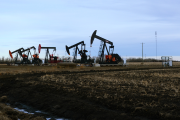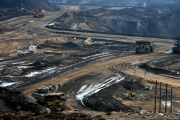Oilsands production is expected to surpass 2 million barrels per day this year. Approved production exceeds this amount by nearly three times; planned projects by nearly five.
In its rush to build new projects and ramp up production, the oilsands industry is driving an unfamiliar road with its foot jammed on the gas pedal — regardless of what turns or hazards may lie ahead.
This full-speed-ahead approach doesn’t necessarily serve the industry’s best interests, increasing costs for construction materials and labour, and overwhelming the existing infrastructure needed to move the product to market.
But it carries even more risk for Alberta. Rapid development increases competition for inputs and can lead to higher production costs. This reduces per-barrel royalties and corporate income taxes — the benefits Albertans receive from the resource — which are paid out of the net revenue companies earn. A heated economy has also contributed to an inflated cost of living for everyday Albertans and put an increasing strain on Alberta’s infrastructure and social services.
Rather than simply maximizing the rate of extraction, the Alberta government has a role to play in leading a discussion on how to manage oilsands development in a way that optimizes the benefits to Albertans, and minimizes the risks.Rather than simply maximizing the rate of extraction, the Alberta government has a role to play in leading a discussion on how to manage oilsands development in a way that optimizes the benefits to Albertans, and minimizes the risks. It’s time to ease up on the gas pedal, and drive according to the road conditions.
The Pembina Institute took a closer look at the long-term economic implications of rapid oilsands expansion in a report called Booms, busts and bitumen, released with Quebec-based environmental group Équiterre. Our analysis found that the current approach to oilsands development is creating economic challenges both in Alberta and in other sectors and regions. To address this, we also outlined some steps our governments could take to better manage those risks and enhance the long-term prosperity of Albertans, and all Canadians.
Albertans got a preview of the downsides of over-reliance on oilsands development earlier this year, when the government announced a $6.2 billion shortfall in anticipated non-renewable resource revenues for Budget 2013. In the words of Premier Alison Redford, the austerity budget that followed required the government to “make some very difficult choices.” Meanwhile, bitumen production levels were hitting record highs.
Yet the risks for Alberta are not limited to the province’s current fiscal challenges.
This fall, both the Intergovernmental Panel on Climate Change and the International Energy Agency stated that if the world is to have a reasonable chance of staying below 2°C of warming (the threshold that scientists say offers a good chance of avoiding dangerous climate change) then a significant portion of proven fossil fuel reserves — up to two thirds — must stay in the ground. As David Emerson, chair of the Alberta Premier’s Council for Economic Strategy, noted in 2011, “We may have heavy oil to sell, but few or no profitable markets wishing to buy.”
For a government that is already heavily reliant on one-time resource wealth, that should be a sobering prediction. Receiving the vast majority of the benefits during the boom means that Alberta is also most susceptible to falling hard should the bust arrive.
Our intention, in publishing this analysis, was to draw attention to the need for a rational discussion that considers the risks, as well as the rewards, of rapid oilsands expansion. Unfortunately, the Government of Alberta dismissed our findings and recommendations out of hand, with Energy Minister Ken Hughes stating, “to argue that the benefits are not distributed across the country I think is naive, ill-informed and does not reflect the facts.”
The facts, according to the Canadian Energy Research Institute, are that 94 per cent of the GDP benefit, and 86 per cent of employment opportunities, from the oilsands are concentrated in Alberta. We don’t take issue with Alberta seeing the bulk of the benefits from the development of its resources — but it’s important to manage the immediate benefits in a manner that best ensures Albertans will enjoy long-term prosperity.
So here is what we recommend: to start, the Alberta government must improve the management of one-time resource wealth. It is far from guaranteed that future demand for the oilsands will be high enough to support planned supply. To guard against year-to-year volatility and ensure the next generation of Albertans benefit from this resource, the province should do more to grow its long-term resource wealth fund.
It would also be wise for both the provincial and federal governments to direct resource revenues towards capital investments that reduce fossil fuel dependency. Investment should support the development and deployment of clean energy technologies, encouraging Alberta to diversify its economy and capitalize on emerging opportunities in this sector.
Reforming the way new oilsands projects are evaluated is also a critical step. Current review and approval processes evaluate only the short-term benefits of a project, not the downsides of fast development. Economic and environmental costs must be considered as well. Moderating the pace of development by ensuring that projects are only approved when their net benefit is positive would help to ensure that Albertans see maximum value from the development of the resource.
While some amount of volatility and risk will always accompany resource development, managing how those resources are developed can go a long way toward minimizing our risk exposure. Both the Alberta and federal government must take action today to build a more resilient economy, backed by policies that will ensure Canada’s long-term economic competitiveness and maximize the value of the oilsands — today and into the future.
Sarah Dobson is lead author of the report Booms, busts and bitumen: the economic implications of Canadian oilsands development.







